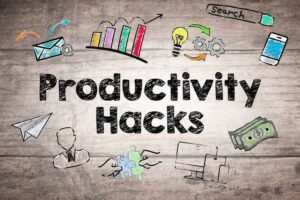In an era where life is intertwined with technology, “screen time” has become a crucial metric for our lives. We work, communicate, and relax on screens, creating an unbreakable and sometimes even overwhelming cycle. The real challenge today lies in mastering technology in our lives, not eliminating it, which is nearly impossible. Digital harmony focuses on intentional and purposeful device use, not deprivation. It’s about our devices enriching our complex and ever-changing lives, rather than hindering them. We aim to recover time, attention, and well-being from the hectic pace of the digital world.
Understanding the Modern Digital Dilemma:
Balance begins with understanding why this is such a pressing problem. Modern screens are interactive, algorithmically driven, and designed to hold our attention for as long as possible. Social media, streaming services, and news feeds use complex neural signals to release dopamine, creating a cycle of craving and reward that is difficult to break. This artificial experience can lead to “techno-distraction,” where technology disrupts our real-life relationships and activities. It’s crucial to recognize the pull of these platforms. It shifts responsibility from individual mistakes to planned, dynamic, stimulating, thoughtful, and structured engagement.
Consciously Evaluate Your Digital Diet:
You can’t manage what you don’t measure. First, honestly assess your screen time. Most smartphones have a digital well-being app that clearly displays your daily and weekly routines. Observe it for a week, without judgment. Could you please consider how much time you allocate to aimless scrolling compared to productive work? Which apps make you anxious or comparative, and which are beneficial? The goal of this assessment is to identify trends and emotional triggers, not to shame you for excessive use. You might reach for your phone when you’re bored, anxious, or socially awkward. This awareness can help you shift from “autopilot” to conscious choices and make real changes.
Set Effective Limits on Your Personal Technology:
After self-awareness, set realistic limits. General advice like “use your phone less” doesn’t work. Instead, create rules tailored to your specific lifestyle. An effective approach is “tech-free zones” and “tech-free times.” For example, remove charging stations from your bedroom to create a restful sleep space. The first hour of the morning and the last hour before bed should be screen-free, allowing your mind to naturally wake up and unwind. To stay connected with others during mealtimes, keep devices out of sight. Use app timers to limit social media and entertainment app use beyond your daily limits. These limits are guardrails, not cages, allowing you to make better choices without willpower.
Enjoy the Joy of Missing Out (JOMO):
FOMO—the fear that others will have a better experience without us—leads to excessive screen time. We must actively promote JOMO, or the Joy of Missing Out, to combat this phenomenon. JOMO is a conscious, enjoyable choice to disconnect from yourself and your surroundings. It can be the pleasure of a good book, a conversation, a nature walk, or simply doing nothing at all. Cherish your personal experiences with the highlights created by others. Plan offline activities you enjoy and fully immerse yourself in them to practice JOMO. This approach will transform detachment into a significant increase in stillness, creativity, and interaction in the real world.
Prioritize Screen Time, Not Scrolling:
Not all screen time is created equal. The goal is to distinguish between passive and active technology use, not to devalue it. High-quality screen time includes video chatting with distant relatives, taking online classes, reading insightful articles, and managing finances. Low-quality screen time, such as aimlessly scrolling, can be tiring and unsatisfying. Strive to choose worthwhile activities. Ask yourself, “What is the purpose of my phone?” before picking it up. This brief pause enables you to select your focus, preventing you from becoming entangled in a digital cycle.
Engaging in Analog Hobbies Fosters a Physical Connection:
Actively participating in real-world activities can reduce screen time. When our offline lives are fulfilling, the digital world loses its appeal. Consider returning to analog hobbies or trying something new that requires hands-on, focused attention. Think gardening, cooking, painting, woodworking, playing an instrument, or joining a local sports league. These activities offer a sense of fulfillment and engagement that virtual experiences rarely achieve. They stimulate multiple brain areas, relieve tension, and allow you to experience joy and satisfaction beyond the pixelated screen.
Conclusion:
Balancing screen time with the real world requires conscious choices, not a single destination. This means adapting to the ever-changing digital landscape and taking care of ourselves. Understanding the dynamics, evaluating our habits, setting specific boundaries, and actively seeking joy in the offline world can transform our relationship with technology. The technology that captures our attention can become a tool for connection, productivity, and enjoyment. The ultimate goal is to live a life where technology benefits but does not dominate, allowing us to fully enjoy irreplaceable moments.
FAQs:
1. What is a reasonable amount of screen time per day?
There is no “right” number of hours, as screen time needs vary depending on your career, lifestyle, and personal goals. Quality and purpose are more important than quantity. Instead of setting hourly limits, focus on creating valuable screen time that doesn’t impact your sleep, relationships, or mental health.
2. How can you limit screen time without fighting with your child?
Start by leading by example. Establish clear family rules, such as no screens during mealtimes or family activities. Encourage offline activities like board games, outdoor activities, and creative projects, rather than simply banning screen time. Parental controls should be used as a tool to help your family set healthy boundaries, not as a punishment.
3. Are there tools I can use to improve screen time management?
Many current devices have built-in tools. Screen Time and Digital Wellbeing are available for iPhones and Android devices. You can set app timers and wind-down intervals and view detailed reports. Freedom of Forest can block distracting websites and apps on all your devices, helping you focus better.
4. I have to use my phone for work. How do I set boundaries?
Work-related screen use should be differentiated. Keep work and personal apps or profiles separate, if possible. After work, close all work-related tabs and apps, mute non-urgent notifications, and put your laptop aside for a “digital shutdown.” Even if you use the same device, these steps help mentally separate work and personal life.
5. Why does unplugging make me anxious?
Modern anxiety is often associated with FOMO (fear of missing out) and app-driven dopamine feedback loops. Start with a 30-minute walk without your phone. As you get more used to it, you can gradually increase the length of your walks. As your mind resets and you discover the joy of being present, your worries will gradually diminish.


